Supermicro AS-1013S-MTR Management
These days, out of band management is a standard feature on servers. Supermicro offers an industry standard solution for traditional management, including a WebGUI. This is based on the ASPEED AST2500 solution, a leader in the BMC field. The company is also supporting the Redfish management standard. On this motherboard, we see similar features as we would across the Supermicro X11/H11 ranges. That means whether you are using an embedded Intel motherboard or a 4U EPYC storage server, you will have a similar look and feel to the management experience.

In the latest generation of Supermicro IPMI is an HTML5 iKVM. One no longer needs to use a Java console to get remote KVM access to their server.

Currently, Supermicro allows users to utilize Serial-over-LAN, Java or HTML5 consoles from before a system is turned on, all the way into the OS. Other vendors such as HPE, Dell EMC, and Lenovo charge an additional license upgrade for this capability (among others with their higher license levels.) That is an extremely popular feature. One can also perform BIOS updates using the Web GUI but that feature does require a relatively low-cost license (around $20 street price.) That is a feature we wish Supermicro would include with their systems across product lines.
Supermicro AS-1013S-MTR Block Diagram
With the AMD EPYC architecture, block diagrams matter to many buyers. This is because each AMD EPYC socket is comprised of four pieces of silicon, each is its own NUMA node. Here is what the overall block diagram for the H11SSL, the motherboard of the server, looks like:

The major difference here is that our test system uses the Supermciro H11SSL-i which does not have the LSI controllers
Supermicro AS-1013S-MTR Performance
As mentioned earlier in this article, we swapped processors from throughout the AMD EPYC 7000 range. AMD has many SKUs in their range capable of dual socket operation, so we picked a few samples to show how incrementing CPU levels impact performance. Running through our standard test suite generated over 1000 data points for each set of CPUs. We are cherry picking a few data points to give some sense of CPU scaling with each solution.
Python Linux 4.4.2 Kernel Compile Benchmark
This is one of the most requested benchmarks for STH over the past few years. The task was simple, we have a standard configuration file, the Linux 4.4.2 kernel from kernel.org, and make the standard auto-generated configuration utilizing every thread in the system. We are expressing results in terms of compiles per hour to make the results easier to read.
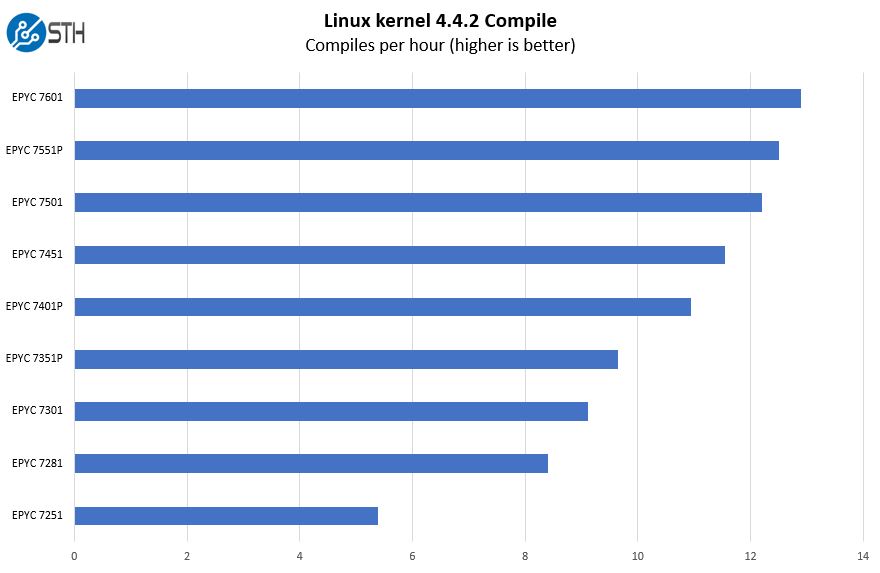
If you see the “P” series parts those are certainly special in the AMD range. They are AMD’s single socket only CPUs designed for systems like the Supermicro AS-1013S-MTR. You can see a fairly linear performance increase from the bottom of the stack to the top. If you are a dedicated hosting provider, the EPYC 7251 is the lowest cost option. Otherwise, we strongly suggest using the EPYC 7351P, EPYC 7401P, or EPYC 7551P.
c-ray 1.1 Performance
We have been using c-ray for our performance testing for years now. It is a ray tracing benchmark that is extremely popular to show differences in processors under multi-threaded workloads. We are going to use our new Linux-Bench2 8K render to show differences.
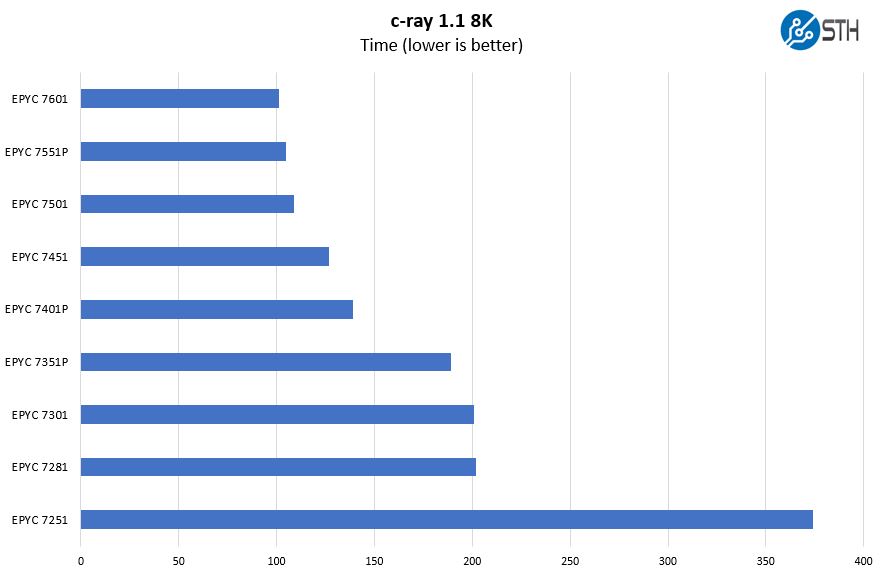
This is a great chart that we use to show the differences between the different lines. One can see the major jump from the EPYC 7251 to the EPYC 7281 which is an 8 core to 16 core jump.
7-zip Compression Performance
7-zip is a widely used compression/ decompression program that works cross-platform. We started using the program during our early days with Windows testing. It is now part of Linux-Bench.
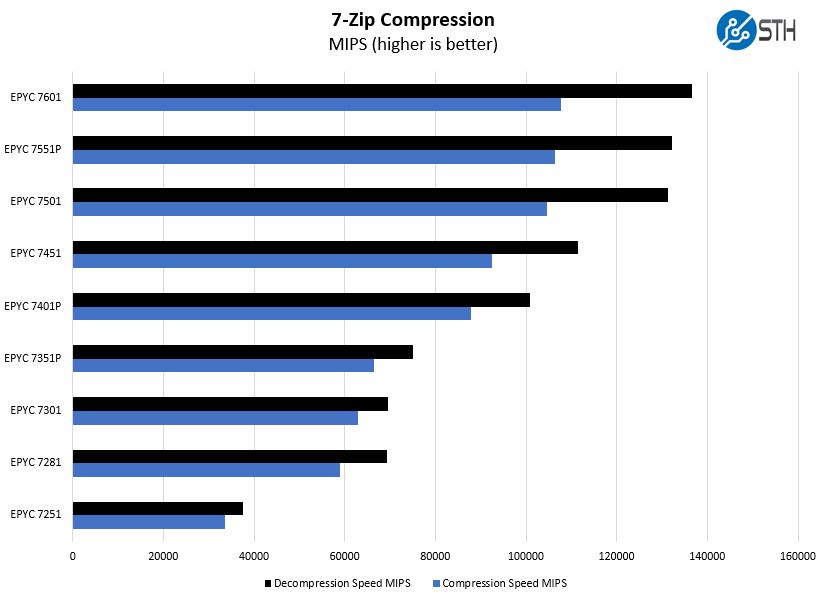
AMD EPYC 7000 series CPUs tend to perform better here on the decompression versus the compression side.
OpenSSL Performance
OpenSSL is widely used to secure communications between servers. This is an important protocol in many server stacks. We first look at our sign tests:
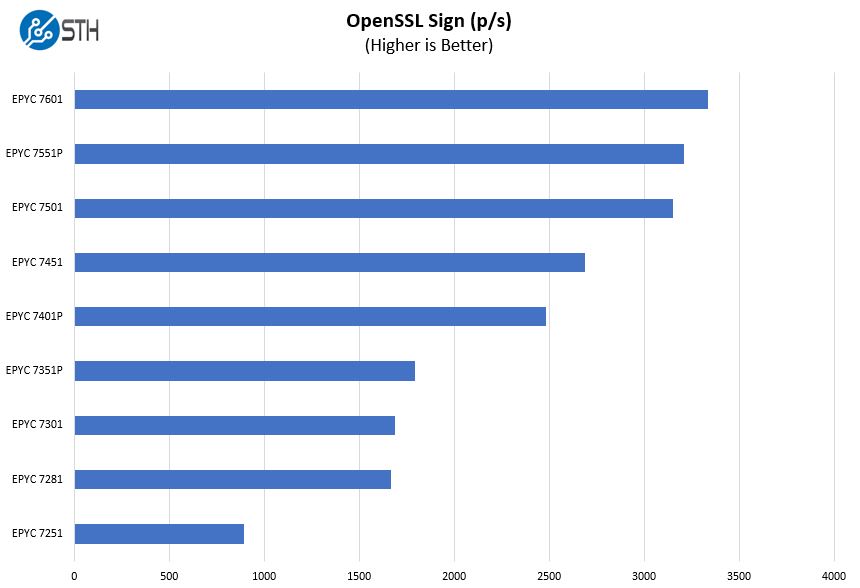
Here are the verify results:

In the dedicated hosting market, OpenSSL is going to be used by many customers. One can see the scaling that AMD EPYC 7000 shows. If you want to see some Intel comparison points, you can check out our individual benchmark pieces like the AMD EPYC 7401P Linux Benchmarks and Review – Something Special where we show the Intel comparison. Here, we are showing all the options for the Supermicro AS-1013S-MTR system.
Chess Benchmarking
Chess is an interesting use case since it has almost unlimited complexity. Over the years, we have received a number of requests to bring back chess benchmarking. We have been profiling systems and are ready to start sharing results:
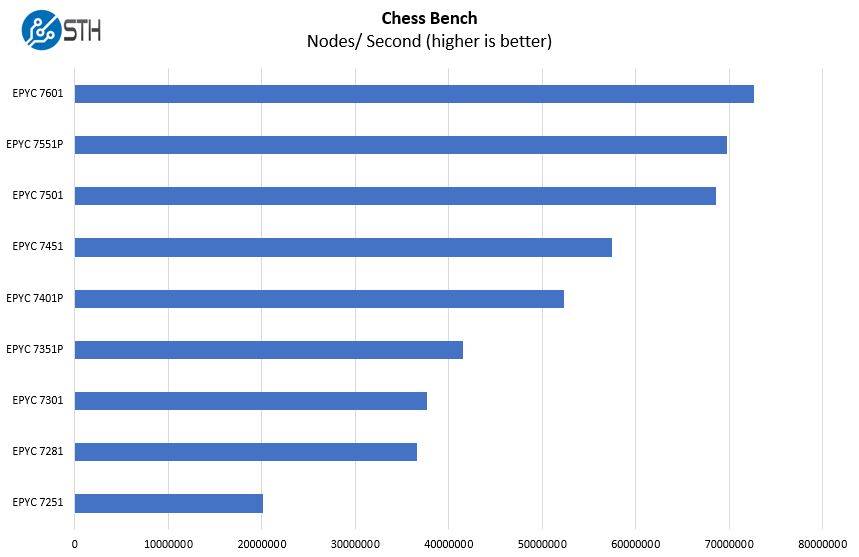
Here again, we see fairly linear scaling throughout the range.
The performance of the AMD EPYC “P” series SKUs is simply awesome. With the exceptional pricing, the price/ performance of these three SKUs is the top of the AMD EPYC range and something that Intel Xeon Scalable simply cannot match. Check out STH for AMD EPYC v. Intel Xeon Scalable reviews.
Next, we are going to look at the power consumption before getting to our final thoughts.

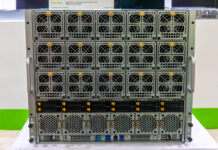


The model seems much too simplistic, given the number of PCIe channels available from the “P” series EPYC CPUs, I would have expected 10Gbe LAN connections to be standard. As well as options/models with 2×2.5″ NMVe + 8×2.5″ SATA/SAS as well as 10×2.5″ NMVe drive bays to be available for single CPUs (Instead of Supermicro only making those options/variations available as dual CPU systems).
BinkyTO I get where the review is coming from though. This is like $3600 USD for the barebones, a 24 core chip and 128gb of ram. Add another $1000 for drives and for $4600 USD you’ve got a system we can lease for $750 day in and day out. Even with hosting costs you’d get payback in a few quarters. I don’t think it’s great if you aren’t selling dedicates but for us this is what we’ve been waiting for.
@BinkyTo
The motherboard makers must have good reasons to make all the cool-boards for an other brand of CPU.
It’s not just Supermicro, it’s all of them. 128 PCIe-lanes and nobody is using its real potential, makes you wonder…
@BinkyTo @Misha Engel:
Here pushing single AMD EPYC to the limit.
https://www.tyan.com/Barebones_GA88B8021_B8021G88V2HR-2T-N
@Jay C,
Supermicro already has 1U model with the storage setups I am looking for, but they require dual EPYC CPUs — when a single EPYC has the same number of PCIe lanes as a dual CPU setup. So there is no reason to require dual CPUs.
@Misha,
These are the same mobo manufacturers that create 31 mobo’s when the Intel Skylake CPUs or when Intel released were released. Never mind the number of mobos required to support the latest “CxxxxxxFxxk” of Bronze, Silver, Gold and Platinum Intel XEON CPUs… especially, when they have a 1U chassis which supports dual EPIC CPUs already listed/available.
From the comments in the review it is not easy to understand if the 16 sata3 ports in the motherboard are functional or Supermicro included a special version of the motherboard with reduced specs. Any of you can help me with that doubt? I’m looking to buy one of these and it will be my first supermicro system.
Thanks